A Soquel History Tale
by Carolyn Swift - former Director, Capitola Historical Museum
A Soquel tall tale involves a man of the pioneer era who tried to hock
his footwear for a pint of whiskey at a local saloon.
He asked the proprietor if he could "soak his boots." When the saloonkeeper grumbled, "You go and soak hell," the reaction tickled the bar patrons so much they applied the name of Soquel to the saloon, the ground it stood on and the entire surrounding township.
A century ago, this knee-slapper might have been hilarious, but the yarn was far from true, given the legacy of the Soquel Indians and the Rancho Soquel land grant that preceded American settlement-and yet, there is still good reason for hitching the sound of "soak" to Soquel.
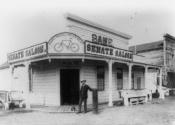
Sam's Senate Saloon
William "Billy the Barber" Kropf struck a dapper pose outside Sam's Senate Saloon at Porter Street and the highway known these days as Soquel Drive. The saloon was one of several bars in the village where a patron might try to "soak his boots" for a shot of whiskey. Billy's companions in this photograph were a dog and a cat resting in the doorway.
Throughout its history, the village was waterlogged at regular intervals. Records list more than a dozen severe floods. The town's beginnings, in fact, can be traced to a deluge in the winter of 1847, when a sawmill on the banks of Soquel Creek washed away in a storm. The mill had been built in 1846 by John Daubenbiss and John Hames for Soquel Rancho owners Martina Castro and her husband, Michael Lodge. The mill, its storage yard and millpond dam, located just below the present site of the Soquel Lions Park on Main Street, were initially paid for with herds of sheep and Spanish cattle, the Californio equivalent for currency. Lodge also promised cash later from the mill's profits to settle the total debt of $5,000.
Hames and the Lodges went to the mines during the Gold Rush. Michael never came back and was believed murdered on his way home. Hames, returning to find the Soquel mill rebuilt on higher ground, eventually filed suit against the widowed Martina in a futile effort to collect payment.
Pioneers Hames and Daubenbiss bought the neighboring Rancho Rodeo in 1847 and started gristmills and a flourmill. They set out a cemetery, planted farms and gave land for Soquel's first schools. Wisely, most of their endeavors sat above the floodplain. The blacksmith shops, stores, hotels and saloons of the business center, though, were stretched along transportation routes and junctions near stream crossings. Soquel Creek ran through the middle of town and was known on occasion to surprise people by creeping into their houses in the middle of the night. When a nasty flood tore up the landscape in 1862, shopkeepers realized the town sat in a basin. They lugged dirt from surrounding hillsides and added fill to the floodplain. Commercial buildings downtown were built on stilts wherever possible. New dwellings were set back toward the hills. Much of the community remained, however, in the shallow spot where water was directed naturally in a storm.
By the 1890s, three bridges sat in the center of town, at Bridge Street, Walnut Street and Soquel Drive near Main Street. In January 1890 flooding battered the downtown district after logs jammed up below the South Coast Paper Mill on Paper Mill Road. Villagers were dumbfounded when they saw barns and houses undercut and sagging over the creek.
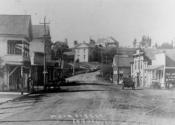
Soquel Drive-Daubenbiss Home
The homes of John Daubenbiss and his brother, Henry Daubenbis, center, were securely set above the floodplain. An early automobile can be seen to the right in this photograph taken at a spot east of intersection at Soquel Drive and Porter Street, c1910.
People got used to rainy seasons that were sopping wet inside and out. The late Ceedola Parrish Duff, granddaughter of pioneers Joshua and Narcissa Parrish, founders of the Soquel Congregational Church, had vivid memories of watching as neighbors bustled toward higher ground.
"Every winter for awhile, until 1919 when Soquel Drive was put in concrete, practically every year it flooded," she said. "The lowlands, the orchards, all were inundated. I remember standing on the bridge, the old metal one, and the water was high up to it. The men were standing with spears tied to ropes, trying to catch the logs as they came down."
Duff also recalled stormy days when-although they were forbidden to do so-she and her classmates avoided the muddy streets and got to school by running along the flume that carried wastes from the paper mill out to the bay.
Nora Angell, the first president of the Soquel Pioneers Association in the 1930s, also remembered the floods of her childhood. She told how the run-off spilled down from the Daubenbiss farm hillside, where it joined the overflow from Soquel Creek and created a lake. She and her family were on their way to the opening of the Odd Fellows Hall.
"Water stood so high on the road they had to make a footbridge out of sawhorses," she said.
After the winter holidays of 1931, the local press reported Soquel families were again singing "River stay away from my door." Six years later, the creek spilled over and sent families on Porter Street dashing for safety. Refusing to leave her cabin was 81-year-old Frances Kropf, the widow of famed local character William "Billy the Barber" Kropf.
The Kropfs had owned a tract on the west side of Porter Street, but when Billy died in 1923, Frances moved into a little cottage nearby that had been built in the mid-1850s by John T. Porter. Since the old house fronted on Soquel Drive and was lower than the road, it was used to being flooded. In 1937, Mrs. Kropf reckoned that she had been evacuated often enough and refused to budge. When the water rose over the floorboards, she took refuge on her bed and finally had to be carried out by rescuers.
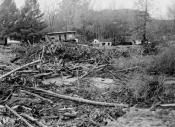
Destruction: Soquel Lodge Six cabins at Soquel Lodge, next to the bridge, were destroyed during the flood of December 1955. Santa Cruz Sentinel reporter Wally Trabing observed that Soquel Creek was transformed into a "Mr. Hyde-like monster." Many residents who were caught unprepared spent the night shivering in their attics and on rooftops.
In 1940, highway workers brought in a crane to lift away logs jammed against the bridge. The scene was to become perennial.
Just before Christmas 1955, more than a foot of rain down poured in three days. Soquel Creek regained its force as a river with amazing speed. Logs, deadwood, fences, doghouses and stray car tires smashed against the bridge and created a dam. Water rose over the top and surged downtown. Windows broke, doors opened, shelves caved in and ornaments drifted with the debris toward the ocean. The estimated damage was more than $1 million.
In January 1982, it happened again, faster and harder. Logs jammed against the bridge at Soquel Drive. The crane could not get there in time. Trees fell on power lines. Rescuers snatched up mobile home park residents shortly before the trailers were crunched like aluminum cans. The town sat in muck for weeks. The damage was severe and took years to repair.
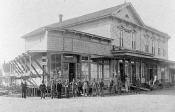
Ned Porter's Store
The contributions of Benjamin, George, John T., and Ned Porter to the development of Soquel were so many that it is difficult to pinpoint which of the brothers and cousins is responsible for the naming of Porter Street. Benjamin and George started the Porter Tannery at Porter Gulch. Benjamin's descendants later built the Soquel Memorial Library. John T. ran an early Soquel business and then became county sheriff. George was a Soquel resident elected to the State Senate. The thoroughfare, however, seems to be named for Ned, who built the village's first store at the corner of Porter Street and Soquel Drive. Ned was one of the developers of the Soquel Wharf Road that conveniently ended at the door of his store, and continued through his property to link with the San Jose Road. Unfortunately, the store and the intersection were in a low spot where the Soquel River naturally diverted in flood conditions. This photograph shows the efforts of later storeowners to make improvements. (Soquel Pioneer Association Photo)
Inside the Soquel Porter Memorial Library, there are marks on the wall to indicate how high the floods have been over the past 50 years. Only now is the community beginning to think of a future on land a bit drier.
The Soquel Village Bridge Replacement Project, totaling $3.5 million, will provide the town a bridge that is two feet higher, lessening the problem of logjams during flooding. Named in memory of Lawrence J. Bargetto, winery owner and a founding member of the Soquel Creek Water District, the bridge is scheduled for completion in December 2002.
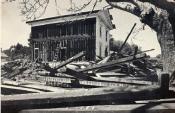
Daubenbiss Home
Pioneer John Daubenbiss built his landmark home in 1868. Constructed of redwood, the dwelling stood for a century before showing signs of needing repair. Used as a halfway house called "Project Back" in the late 1960s, it was painted inside with psychedelic designs and needed more than $50,000 in repairs to the structure by the mid-1970s. The building was saved from destruction by Christina and Jesse Lee Case-Gabbard, who provided a new foundation, restored siding, and a replaced roof. The couple used it for many years as a residence and bookshop-gallery.
